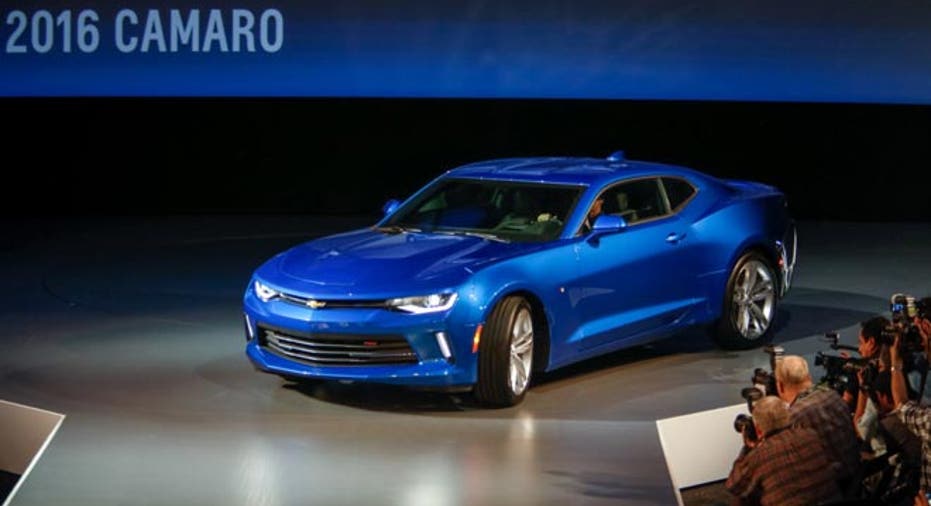Chevy's New Camaro Fuels Muscle Car Race

General Motors (NYSE:GM) is adding more fuel to the muscle car races with a restyled Chevrolet Camaro, looking to maintain its lead over Ford Motor Co.’s (NYSE:F) Mustang.
The sixth-generation Camaro, which was unveiled Saturday in Detroit, will be smaller and lighter than the current model. GM chose to build its 2016 Camaro on top of the company’s Alpha platform, which underpins the Cadillac ATS. The result is a faster, more nimble Camaro, Chevrolet says.
Under the hood, GM is bringing a turbocharged 2.0-liter, four-cylinder engine to the Camaro. An all-new 3.6-liter V6 engine is also in the pipeline. The Camaro SS will sport a 6.2-liter V8 that generates 455 horsepower, topping Ford’s Mustang GT by 20 horsepower.
Todd Christensen, Chevrolet’s marketing manager for the Camaro, said the new powertrain options for 2016 will enable the Camaro to compete with both traditional muscle cars and sporty import brands.
The 2.0-liter engine “gives us the best of both worlds,” Christensen explained. “We hope it broadens the appeal and interest in the new Camaro. At the same time, the V8 still speaks to enthusiasts who want that combination.”
Overall, the Camaro will shed about 200 pounds, and GM expects that its turbocharged model will get more than 30 miles per gallon. Many automakers, including Ford, are combining turbochargers and smaller engines to achieve greater fuel efficiency without sacrificing power.
“It’s a difficult thing to retain that essential Camaro-ness while making it more fuel efficient and lighter, but I think they did a good job,” said Jack Nerad, executive editorial director at Kelley Blue Book.
The Camaro, a famed nameplate that briefly exited Chevrolet’s lineup in the early 2000s, has enjoyed a strong run since its resurrection for model-year 2010.
GM’s pony car has outsold Ford and Fiat Chrysler Automobiles (NYSE:FCAU) every year since the Camaro’s return. Camaro sales rose 7.2% year-over-year to 86,297 vehicles in 2014. That outpaced the Mustang, which tallied 82,635 units sold. FCA sold 51,611 Challengers last year.
Despite the Camaro’s success, GM saw the need to put a fresh Camaro on the road.
“We continue to make the product better, and we felt it was the right time in the life cycle to go all-new,” Christensen said.
Ford and Dodge began selling new versions of their muscle cars in the last year, which raised the stakes for a segment that has been written off several times. Like sport-utility vehicles, higher gas prices were thought to spell the end of muscle cars.
Through April, Camaro sales are down 15% this year at 24,229 vehicles. Meanwhile, Ford has boosted sales of the revamped Mustang by 60% to 42,955 units.
“The muscle car segment is very flavor-of-the-month oriented. If someone has a new product, sales rocket ahead, and then enthusiasm cools when someone else comes out with a new product,” Nerad said.
The 2016 Camaro, which is slated to go on sale during the fourth quarter in LT and SS trims, is truly built from the ground up. According to Chevrolet, only two parts have been carried over from the previous generation: the rear bowtie emblem and the SS badge.
The Camaro maintains recognizable design traits such as a long hood and low roofline. Chevrolet also paid close attention to interior refinement and in-car technology.
Christensen said balancing the Camaro’s iconic past with the needs of modern car buyers is “something that keeps us up at night.”
“You have to make sure you have the brand image and style from years past,” Christensen explained, “but the marketplace requires that the car gets better.”
GM shares climbed 14 cents, or 0.4%, to $35.05 Monday. The stock is up roughly 0.4% since the start of the year.



















